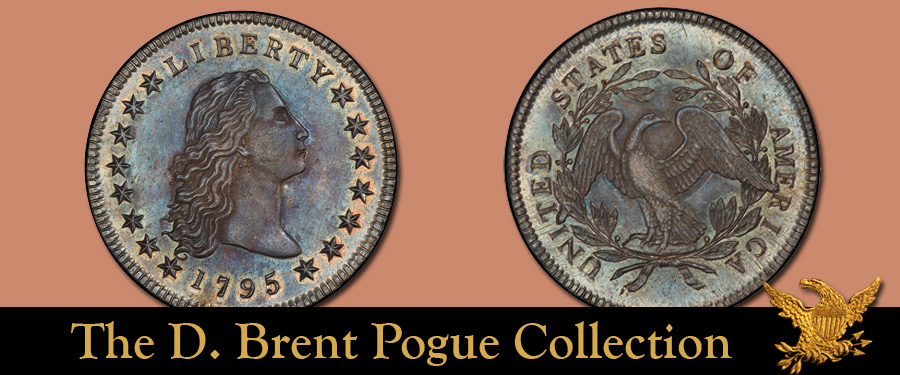
A Remarkable Early Dollar
This memorable Flowing Hair dollar was front row center in Catherine Bullowa’s sale “including my personal treasures” held on December 4, 2005. Today, graded by PCGS as MS-66, it is unique at this lofty level. It was the cover coin in the Bullowa sale and was described as: “Very choice to gem Uncirculated. Prooflike surfaces with deep mirror effect. Perfectly centered, fully and beautifully struck. Gorgeous bluish-purple perfectly balanced color. Superb example.”
Flowing Hair dollars of this year exist across many die varieties and are fascinating to contemplate and collect. Each is different with regard to placement of the stars, numerals, and letters, and there are several distinctions among the portraits. On some reverses there are three leaves beneath each wing instead of the normal two. The standard reference system for early dollars was compiled by Q. David Bowers and Mark Borckardt as part of Bowers’ two-volume Silver Dollars and Trade Dollars of the United States: A Complete Encyclopedia, published in 1993.
Chief Coiner Voigt made the first delivery of 1795 dollars from a new large-capacity press on May 6, amounting to 3,810 pieces. Some of these had probably been overstruck on the dollars of unacceptable quality held back after the first silver dollar coinage of October 15, 1794, were produced on a smaller press that was not able to strike the coins with full details.
The first silver dollars reserved for the annual meeting of the United States Assay Commission were not laid aside until May 16, 1795, when three pieces were put into a special chest in the treasurer’s vault. No meeting had been held in 1795 and none was to come in 1796. The first meeting, which tested all of the silver coinage struck since May 1795, was not held until March 1797. More than 100 silver dollars were tested at that time.
From May through October the coinage of silver dollars was heavy, but not all of these were the Flowing Hair type introduced in October 1794. At some unknown date, probably at the end of September, the design was changed to the Draped Bust obverse, which continued to be coined through March 1804. Existing Mint records are silent concerning this all-important change in design.
The Assay Commission
The first Assay Commission met at the Mint on March 20, 1797, starting a yearly tradition that would last until 1980. During the minting of silver and gold coins (but not other metals) occasional samples were set aside. Early in the following year the Assay Commission would meet. Present would be Mint and government officials as well as, on many occasions, invited private citizens.
The members would select at random a small number of coins from the large quantity of samples set aside for them. While they were watching, some coins would be weighed. For some other coins a Mint employee with scientific skills would use heat and acid to determine the purity of the silver and gold. Those present would sign a document certifying that the samples tested were of correct weight and metallic content per government standards.
After 1965, circulating coins were no longer made of 90% silver, due to the rise in price of that metal on international markets. Gold coins had not been struck since 1933. After 1965, until 1971, half dollars had a reduced silver content. In later years no silver coins were struck. On February 11, 1976, the last public meeting of the Assay Commission was held, as by then the gatherings were mostly ceremonial. On February 13, 1980, the last meeting was held, and the ritual was terminated.





